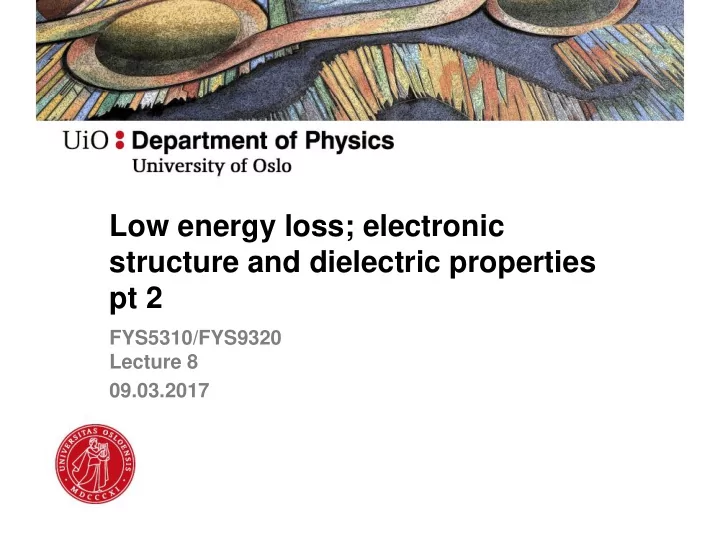

Low energy loss; electronic structure and dielectric properties pt 2 FYS5310/FYS9320 Lecture 8 09.03.2017
Recap from last time 2
• If the initial states are sharply peaked in energy, then all transitions originate at this energy • One particular E i and one particular E takes you to a single point in the conduction band E f • In effect we are convoluting the conduction band DOS with a delta function 𝐸𝑓𝑚𝑢𝑏 𝑔𝑣𝑜𝑑𝑢𝑗𝑝𝑜 ⊗ 𝑑𝐸𝑃𝑇 = 𝑑𝐸𝑃𝑇 • The spectrum reflects a scaled conduction band DOS 𝑤𝐸𝑃𝑇 ⊗ 𝑑𝐸𝑃𝑇 =? • But what if the initial states are in the valence band? 3
The EELS spectrum as a Joint Density of States This is good for core losses: But for single electron transitions in the low loss region we need to consider the convolution of valence DOS with conduction DOS (also called Joint Density of States, JDOS): 𝜁 𝐺 2 𝜍 𝑤𝑐 𝐹 𝑗 𝜍 𝑑𝑐 𝐹 𝑗 + 𝐹 𝑒𝐹 𝑗 𝑔 𝑓 𝑗𝒓⋅𝒔 Ψ 𝑗 𝐽(𝐹) ∝ Ψ 𝜁 𝐺 −𝐹 No dipole approximation? 4
The dielectric polarization of the material The polarization of a material subjected to a time warying electric field is: 𝑸 𝜕 = 𝜁 0 𝜁 𝜕 − 1 𝑭(𝜕) The displacement (total field) in the material is then: 𝑬 𝜕 = 𝜁 0 𝑭 𝜕 + 𝑸 𝜕 = 𝜁 0 𝑭 𝜕 + 𝜁 0 𝜁 𝜕 − 1 𝑭 𝜕 = 𝜁 𝜕 𝜁 0 𝑭(𝜕) So what happens if 𝜁 𝜕 =0? 5
The dielectric function in the Drude model • For free electrons in a uniform background potential, the dielectric fuction is 2 𝜕 𝑞 𝜁 𝜕 = 1 − 𝜕 + 𝑗𝜕/𝜐 Where 𝜕 𝑞 is a harmonic • oscilator resonance frequency given by 𝑜𝑓 2 𝜕 𝑞 = 𝑛 0 𝜁 0 • 𝜐 is the scattering time/damping factor 6
7
8
9
Thickness measurements and the mean free path e - The electron can lose energy to plasmon excitations many times t 10
Thickness measurements and the mean free path 𝑜 𝑜 = 1 𝑢 −𝑢 = 𝐽 𝑜 𝑄 𝑓 𝜇 𝑜! 𝐽 𝑢 𝜇 −𝑢 = 𝐽 0 𝑄 𝑜=0 = 𝑓 𝜇 𝐽 𝑢 𝜇 = ln 𝐽 𝑢 𝑢 𝐽 0 Absolute thickness determination is also possible, but need model or experimental detemination for mean free path 11 F&H
Dielectric function, refractive index, speed of light • The real part of the dielectric fuction gives the refractive index n= • The refractive index gives the phase velocity of light in the material c=c 0 /n . • This is lower than the speed of light in vacuum n Si ( 600 nm, E 2 eV) 4 𝑑 0 𝑑 𝑇𝑗 = 𝑜 𝑇𝑗 ≈ 0,25 𝑑 0 𝑤 𝑓 (200 𝑙𝑊) ≈ 0,7 𝑑 0
13 Erni & Browning, Ultramic (2008)
The Kröger equation 2 2𝐽 0 𝑢 1 𝛾 𝐽 𝐹 = 𝜌𝑏 0 𝑛 0 𝑤 2 𝐽𝑛 − ln 1 + 𝜁 𝐹 Θ 𝐹 14
Only non- relativistic bulk effects E 15 q
Bulk plus relativistic effects E 16 q
Bulk plus relativistic plus surface effects E 17 q
18
19 H. R. Daniels, Phd thesis (2003)
20 Midgley, Ultramic. (1999)
21
Problems for next time 1) Make a plot of the phase velocity of light as a function of refractive indexes n between 1 and 10. The critical acceleration voltage is defined as the voltage giving an electron velocity equal to the phase velocity of a material with refractive index n 2) Make a plot of the critical acceleration voltage as a function of n. 22
Recommend
More recommend